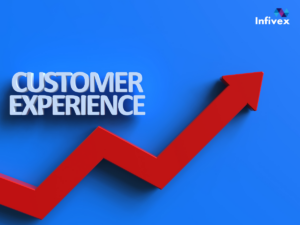Maximizing Customer Satisfaction: Understanding the Key Differences Between Customer Experience and User Experience

I. Introduction
As business owners, we all want our customers to be happy. But with so many terms thrown around like customer experience (CX) and user experience (UX), it can be challenging to know where to focus our efforts.
While CX and UX are both important for a business to succeed, they are not the same thing. In this article, we will differentiate between CX and UX, and provide tips to improve the customer experience in small businesses.
We will also explore the role of customer satisfaction and loyalty, ticket management systems, and AI chatbots in creating a positive customer experience that keeps your customers coming back for more. So, let’s dive in!
II. The differences between customer experience and user experience
Customer experience (CX) and user experience (UX) are two terms that are often used interchangeably, but they are actually quite different. While CX focuses on the overall experience a customer has with a brand or company, UX is more narrowly focused on the experience of using a particular product or service.

CX encompasses every touchpoint a customer has with a company – from the initial attraction to the brand, through to making a purchase, and beyond. CX efforts are aimed at making these touchpoints as smooth and satisfactory as possible to ensure that customers become loyal advocates of the brand.
UX, on the other hand, is focused specifically on how users interact with a product or service. This could refer to a website, a mobile app, a software program, or any other interface that a user interacts with. UX efforts are aimed at making these interactions as intuitive and user-friendly as possible to ensure that users can easily achieve their goals and have a positive experience.

While CX and UX are different, they are both important for businesses to focus on. CX can impact the overall perception of a brand, while UX can impact how users feel about a specific product or service. In order to create a positive overall customer experience, businesses need to ensure that both CX and UX are optimized to meet the needs and expectations of their customers.
III. The importance of understanding your audience
As a professional in any industry, it is crucial to understand your audience. Whether you are a marketer trying to sell a product, a teacher trying to engage students, or a speaker trying to inspire a crowd, knowing your audience is the key to success.
Understanding your audience allows you to tailor your message to their needs and interests. You can speak their language, use examples that resonate with them, and address their specific challenges or pain points. This creates a connection between you and your audience, building trust and credibility.
Furthermore, understanding your audience allows you to choose the most effective channels and mediums to reach them. Are they more likely to engage with written content or video content? Are they active on social media, or do they prefer email communication? By knowing your audience, you can optimize your strategy and maximize your impact.
In short, understanding your audience is not a nice thing to have, it is a must-have. It allows you to create targeted and effective messaging, build relationships, and ultimately achieve your goals. So take the time to research and analyze your audience, and never underestimate its importance.
IV. Creating a customer-centric experience
Creating a customer-centric experience is a crucial aspect of any business strategy. It has become increasingly important in today’s competitive market to focus on providing exceptional customer service and tailoring your products and services to meet the needs of your customers.
The first step in creating a customer-centric experience is to truly understand your target audience. Conduct market research and gather data to identify customer needs, preferences, and pain points. This information can help you develop a deep understanding of your customers and tailor your offering to meet their needs.
Next, develop a customer journey map to identify all touchpoints where your customers interact with your brand. This includes your website, social media, customer service, and more. By analyzing each touchpoint, you can identify areas for improvement and provide a seamless experience across all channels.
One of the most important aspects of a customer-centric experience is effective communication. Ensure that your customers can easily find the information they need and have multiple channels to reach out for support. Set up systems to track customer feedback and respond promptly to inquiries.
Finally, be transparent and honest with your customers. Customers appreciate companies that are upfront about their policies, pricing, and other important information. By building trust with your customers, you can create a loyal following that will continue to support your brand for years to come.
V. Crafting a user-focused experience
Designing a user-focused experience is essential for any business that wants to succeed in today’s competitive market. Whether you run an e-commerce store, a mobile app, or a website, the user experience is critical to your success. Building a user-focused experience requires a deep understanding of your target audience, their needs, and their habits.
To achieve this, start by mapping out every step of the user journey. Define each touchpoint and identify where users might experience pain points or friction. This information will help you design an experience that addresses their specific needs and preferences.
Next, focus on the user interface. A clean, intuitive design can greatly improve the user experience. Use consistent branding, clear language, and easy-to-navigate menus to ensure users can quickly find what they’re looking for.
Finally, continuously gather feedback and data to refine the user experience. Utilize analytics tools to track user behavior and identify areas for improvement. Solicit user feedback through surveys, reviews, and customer support channels to stay in touch with their needs and preferences.
By prioritizing the user experience, you can build a loyal user base and differentiate your business from the competition. With careful planning, thoughtful design, and ongoing iteration, you can craft a user-focused experience that drives success for your business.
VI. How to measure the success of your customer and user experiences

Measuring the success of your customer and user experiences is imperative for any business that is striving to improve its bottom line. In today’s rapidly evolving business landscape, delivering exceptional customer experiences is no longer optional, it is a necessity. It is what sets the most successful companies apart from their competitors.
To measure the success of your customer and user experiences, you need a clear understanding of what success means to your company and customers. This can be achieved by setting clear goals and objectives in conjunction with your business strategy. Once you have identified these goals, you can establish metrics to measure them.
To measure the success of your customer and user experiences, you need to evaluate factors such as customer satisfaction and loyalty, engagement rates, retention rates, and customer lifetime value. By analyzing these metrics, you can identify areas where you are excelling and areas where you need to improve.
To gather the necessary data to evaluate these metrics, you can use a variety of tools and methods, such as surveys, focus groups, data analysis software, and customer feedback programs. Once you have gathered this data, you can use it to optimize and improve your customer and user experiences.
Measuring the success of your customer and user experiences is not a one-time event but an ongoing process. By continuously monitoring and evaluating your metrics, you can identify trends and patterns that will help you optimize and improve your customer and user experiences for the long term.
VII. Intertwining customer and user experience for optimal results
Integrating customer experience (CX) and user experience (UX) is becoming increasingly important as businesses strive to provide seamless experiences across all touchpoints. Combining CX and UX can lead to optimal results in terms of customer satisfaction, retention, and loyalty.
CX focuses on the overall experience a customer has with a brand, from initial awareness through to post-purchase support. On the other hand, UX is concerned with the user’s experience with a particular product or service, specifically the ease of use, functionality, and design. Combining the two can lead to a comprehensive understanding of the customer journey, which can be used to enhance the experience at each touchpoint.
The key to combining CX and UX is to identify common touchpoints across all channels, such as a website or mobile app. By analyzing feedback from both customers and users, businesses can gain insights into how to optimize these touchpoints to improve the overall experience. For example, incorporating user feedback into the design of a website or improving the functionality of a mobile app can lead to a smoother and more enjoyable experience for both customers and users.
In conclusion, businesses should not view CX and UX as separate entities but rather as complementary components of a holistic customer experience. By intertwining CX and UX, businesses can create a seamless experience that meets both the customer’s and user’s needs, resulting in increased satisfaction, loyalty, and ultimately, business success.
VIII. Conclusion
In the world of business, it is essential to understand the difference between customer experience (CX) and user experience (UX). CX is concerned with the overall impression a customer has of a brand, while UX focuses on the individual’s interaction with a product or service. Both are crucial for creating a successful business. Our ticket management system can provide you with firsthand experience of how well CX and UX can work together.
Contact us now to take advantage of this opportunity and see how we can help take your business to the next level.